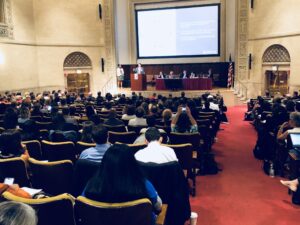
4 Lessons We’ve Learned About Coordinating Community-Wide Networks
Taylor Justice
Unite Us now operates 48 networks in over 20 states. We’re setting a blueprint for communities across the country, and we’ve learned countless lessons along the way. If you’re looking to address social determinants of health or fix the gaps in your community’s care, now is the time to start.
Lesson One:
If you focus on outcomes, you’ll build the right infrastructure.
At Unite Us, our true north is: “Can I prove that each client has received the services they need?” We obsess over end results. To be able to answer this question properly, we need to build the entire supply chain – making sure we map every workflow from each client’s initial engagement to their final resolution. For years, when health, human, or social service organizations considered social determinants of health solutions, they only answered the question, “Where are the resources?” This created a focus on resource directories. But instead of thinking about the next step after identifying resources, the curiosity stopped and organizations were just handing out lists of services to people. Needless to say, this is not a sustainable solution. To truly drive outcomes, we have to do the hard work upfront, and not just hand off tech to users or expect it’s purchasers to handle change management or implement your product themselves. That’s not their job; that’s where a technology partner comes into play.
Lesson Two:
This is about people, not just the technology.
Technology isn’t a silver bullet. It’s a tool. Our goal is to leverage tech that allows humans to connect with other humans in the most efficient way possible. Understanding the pain points of a social worker, a community health worker, a 2-1-1 operator, etc. has been crucial to driving users’ adoption of the tool, which will drive the success of a coordinated network. Technology is useless if no one adopts it, so we take time to show the value of our tool for each of our users. This is how we empower them to make a greater impact in their community while lightening their workload.
Lesson Three:
Models don’t work; processes do.
No one likes to be told what to do. It’s human nature. Any time you try to roll out a new model, be prepared for: “Oh, your model worked in X, Y, Z community? Well, my community is different and it won’t work here.” While there is some truth in this statement – every community is different – this is exactly why you must have a fluid process that can push levers up and pull levers down as needed based on local politics, local personalities, and local workflows. There is no one-size-fits-all solution when it comes to community care. The service category titles (employment, housing, transportation, food, education, etc.) are all the same in every community, but the people managing them aren’t. Look back at lesson number two: this work is about people. People are constantly changing. Listen to them, understand them, and facilitate a process to implement a coordinated network. Don’t just try to implement an off-the-shelf model.
Lesson Four:
No organization should have priority over another.
Health systems and health plans have larger budgets than community-based organizations (duh). However, to effectively address the social determinants of health in communities you must bring human and social services to the same priority level as healthcare. Just as a health system will require integration with their electronic health record (EHR) vendor because they don’t want their staff logging into numerous tools, we must also make the same consideration of the human and social service providers. People only working within their own silos is how we got into this mess of fragmentedservice delivery in the first place. Flip your view of the world to focus on the community-wide care coordination network and how well health, human, and social organizations fit into that. When organizations break down these invisible walls, it allows them to see holistic patient journeys both inside their own facility, and more importantly, outside their facility and across the continuum of care.
These are just four of many lessons we’ve learned over the years and by no means a comprehensive list. These arebasics that can help any community set the stage and frame the conversation about how to build a community-wide care coordination network. These foundational principlesshould help facilitate harder discussions around security, privacy, data rights, evaluations, outcome standards, and more.The message I want to emphasizehere issimple: no one person, no one organization, and no one technology platform can solvethe gaps in community care alone.
To learn more about how Unite Us is coordinating care across sectors:
About Unite Us
Unite Us is the nation’s leading software company bringing sectors together to improve the health and well-being of communities. We drive the collaboration to identify, deliver, and pay for services that impact whole-person health. Through Unite Us’ national network and software, community-based organizations, government agencies, and healthcare organizations are all connected to better collaborate to meet the needs of the individuals in their communities.



